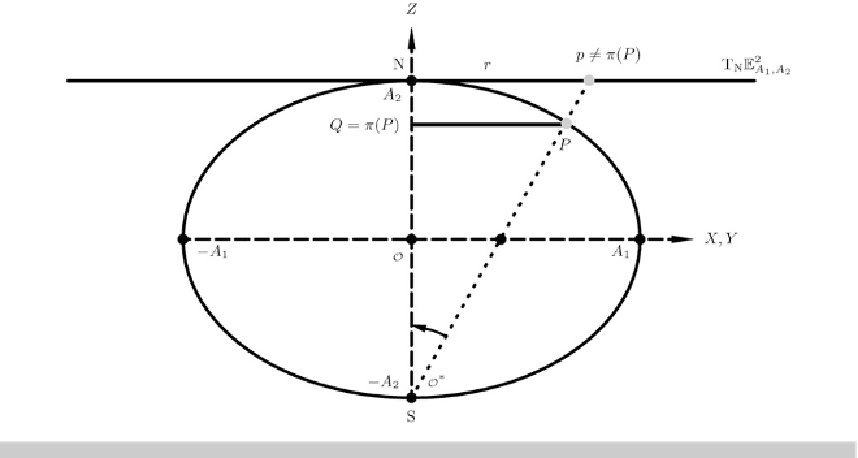Geography Reference
In-Depth Information
∈
E
2
A
1
,A
2
to
p
T
N
E
2
A
1
,A
2
, perspective center S
Fig. 8.5.
Stereographic projection of
P
∈
8-23 Equiareal Mapping
Let us postulate an
equiareal mapping
of the ellipsoid-of-revolution onto a tangential plane at the
North Pole by means of the measure
Λ
1
Λ
2
= 1. The details of such a mapping are collected in
Box
8.7
. At first, we have to start from the canonical postulate of an
equiareal mapping
,namely
Λ
1
Λ
2
=1or
f
(
Δ
)(1
E
2
cos
2
Δ
)
1
/
2
f
(
Δ
)(1
E
2
cos
2
Δ
)
3
/
2
/
(
A
1
sin
Δ
(1
E
2
)) = 1, an equation
−
−
−
solved for
f
d
f
=
A
1
(1
E
2
cos
2
Δ
)
2
. Direct integration leads to
f
2
/
2asan
integral solved by“integration-by-parts”. Four integrals leads us to the final integral
f
2
/
2asa
function of (i) ln[(1 +
E
cos
Δ
)
/
(1
E
2
)sin
Δ
d
Δ/
(1
−
−
E
cos
Δ
), and (iii) 1
/
(1 +
E
cos
Δ
). By
the postulate
f
(
Δ
= 0) = 0, we then gauge the integration constant
c
. In summary, we get the
mapping equations
f
(
Δ
)and
f
(
Φ
), or ((
α
=
A, r
=
f
(
Δ
)), or (
x
=
f
(
Φ
)cos
Λ, y
=
f
(
Φ
)sin
Λ
).
The
left principal stretches
and the
left eigenvectors
are collected in Box
8.7
by (
8.73
)andby(
8.74
).
We finally conclude with the
left maximal angular distortion
(
8.75
).
−
E
cos
Δ
)], (ii) 1
/
(1
−
Lemma 8.11 (Normal mapping: ellipsoid-of-revolution to plane, equiareal mapping).
The equiareal mapping of the ellipsoid-of-revolution to the tangential plane at the North Pole is
parameterized by
x
=
f
(
Δ
)cos
Λ,
(8.65)
y
=
f
(
Δ
)sin
Λ.
subject to the left Cauchy-Green eigenspace
. The radial function
r
=
f
(
Φ
)
that represents an equiareal mapping is given as a
four terms integral
in a closed form.
{
E
Λ
Λ
1
(
Φ
)
,
E
Φ
Λ
2
(
Φ
)
}
End of Lemma.



Search WWH ::

Custom Search